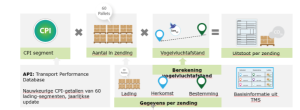What is so useful about a CPI as an indicator? Don’t we already have key figures, for example on CO2emissionsfactors.nl, of emissions per tonne.km?
The existing key figures are averages subject to a lot of assumptions. This still works well with large, stable flows, based on annual averages. But if you want to use them to calculate the emissions of parts, let alone specific journeys, things go completely wrong. Then you get CO2 emission results that may be very far removed from reality. We have once calculated an example of a van that delivers a 1-ton pallet and returns empty. The CO2 emissions converted back to diesel gave a theoretical consumption of 1 liter in 3 km.
A CPI can be used to estimate the emissions of individual shipments, if you have the correct CPI that suits the logistics segment. And the calculation is very simple to perform.
As stated in the previous post, the CPI is a natural by-product of good detailed calculations according to the ISO-14083 standard: you first calculate it for an entire journey. The CPI is a measure of the logistical effectiveness of the journey, also for combined transport.
To determine the emissions of each shipment during the journey, you make a simple calculation based on quantity, origin location and destination.
Yes, but, many say, the route does matter and it is not included in the calculation? The answer is: that is correct, but the is already indirectly included in the calculation of the CPI. The route leads to energy consumption leading to CO2 emissions. And you divide those emissions over the shipments. The CPI is the distribution measure

The Top Sector Logistics has shown that the CPIs for transport in one segment are quite close to each other. But there is a significant difference between segments. That makes sense: supermarket deliveries are similar, as is international FTL transport, but they are very different. That is not due to the truck or the driver, but to the logistics structure of the supply chain.